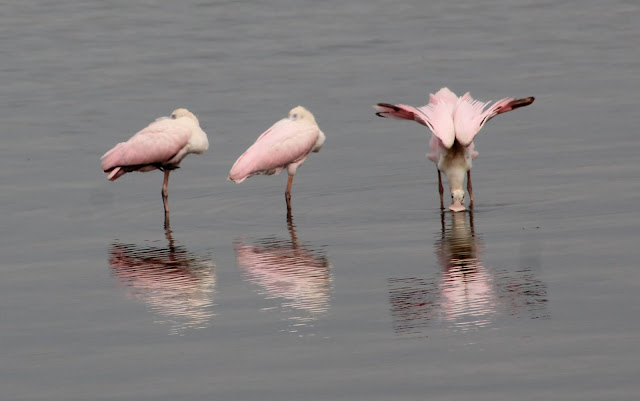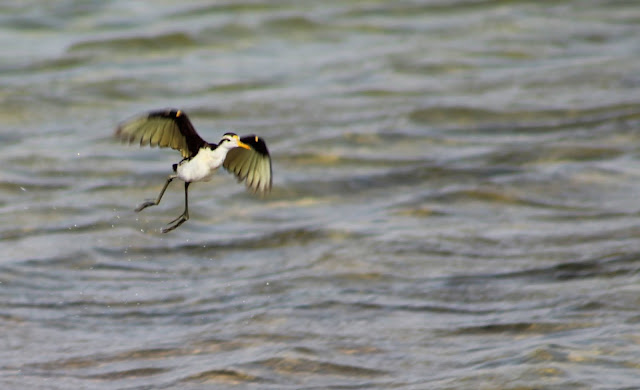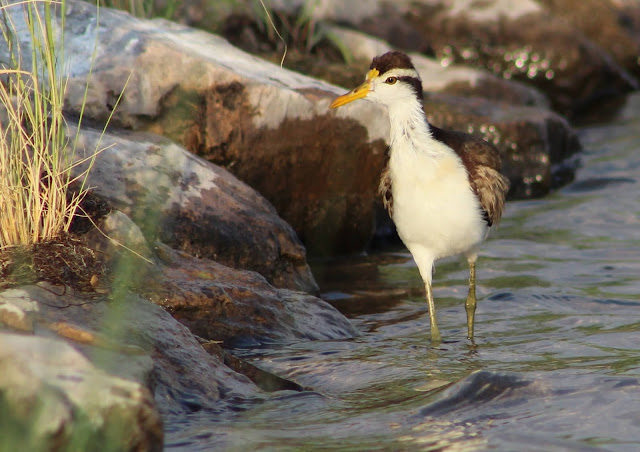When I got back from the Seven Springs/Camp Creek area on September 11th, reports came into the birding community from Jennie McFarland and Richard Fray that Jennie had found three Roseate Spoonbills at the Glendale Recharge Ponds. I knew I wouldn't mind seeing these awesome birds, and it's only a ten minute drive from my home in Peoria to the ponds. When I got there I joined Caleb, Jeff, Levi, Louis, and Pierre. We all enjoyed the Spoonbills, and we also looked for birds in other five ponds.
Then, something really awesome happened for my Maricopa County birding, and everyone else's Maricopa County birding. Caleb spied a Common Nighthawk flying over the basin, and it foraged and dove down at prey a few times. In Maricopa County, Common Nighthawk isn't "Common" at all. Back in the day, I had my first Common Nighthawk sighting near my Grandfather's house in mid-November of 2002. We were walking through the neighborhood, and I flushed a bird that I described as having, "boomerang shape wings with white bars near the end of the wing". I also noted the bird giving a loud call, and that call stuck with me. When I got home, I listened to Common Nighthawk calls and it was the match. As time went on, I realized that a Common Nighthawk in November is freaking rare. I know I had a nighthawk, but could a Lesser Nighthawk pull something off that is loud like a Common on rare occasions? In recent days, the record has had me wondering if I really saw that bird, even though I identified it right. When Caleb spied this Common Nighthawk while we were Spoonbill watching, it became the first Common Nighthawk documented in Maricopa County by photograph. We were all stoked at the sighting. With Common Nighthawks in visual comparison to Lesser Nighthawks, they have the white bar further down on the wing and closer to the wrist than Lesser does, a tern-like flight, and darker primaries. We watched the bird for about a minute before it went off. What a huge highlight and bird it was for me, thank you Caleb!
The Common Nighthawk was one that turned out to be reliable. As I write this now, it has been present and chasable at Glendale for a week now. Birders have been finding it in the evening and early morning. On September 12th, I was driving home from work and was planning to go grocery shopping and then spend the rest of the day at home. When I was about to get to the store, Caleb texted me saying, "Chris Benesh has a Canada Warbler at Gilbert Water Ranch". I forgot about everything else and took a 45 minute drive to Gilbert to for a bird chase. In Arizona, Canada Warbler is a very rare bird. Really freaking rare. Once getting to Gilbert, I made my way to the spot that Benesh had indicated where the warbler was. There were already plenty of birders there, including Chris and Holly Thomas. Holly was the one who identified it first, and she and Chris had the local birding community in a search after their awesome find. Despite many many pairs of eyes looking for the Canada Warbler, it wasn't to be re-found for the rest of the day. Caleb got there and had two shorebirds flying around while calling. He felt like they were Buff-breasted Sandpipers. However, Chrissy Smith had an awesome detection when she was birding around and she found an Eastern Kingbird in Pond 5 of the ranch. Many birders flocked over to see the Kingbird. This was only the second time I've seen this species in Maricopa County (as well as in Arizona), and it was fun to see it and watch it forage alongside a Western Kingbird.
September 13th was a day that birders were hoping the Canada Warbler would be re-found. It is one that is a very challenging statebird to land. Troy Corman was saying that in his years of birding Arizona, he has never been able to get a Canada Warbler in Arizona. Ronnie and Caleb were teaming up, and would be at Gilbert. Scads of birders were there for the day, and the Eastern Kingbird was a big reason for the turnout. Luckily, Caleb worked up some magic and relocated the Canada Warbler! It was along the same path in between ponds 3 and 4 of Water Ranch. I was already prepared to chase the bird after work, and 1 P.M. couldn't have come around sooner. At about 1:45 when I was pulling up to the ranch, birder Alex Grant had relocated the Canada Warbler along the path between ponds 4 and 5. I was hoping that this would be an easier spot to see the bird. In the previous and limited viewing haunts of this Canada Warbler, the vegetation was dense and the bird would be seen with quick, fleeting glimpses. Earlier in the morning, many were able to see it, but not many were able to photograph it. I walked up to the new spot and there was a crowd of about 15 birders there. Luckily, it had been seen about 5 minutes before I got there. After about 5 more minutes of waiting, I heard the phrase I wanted to hear that goes, "here it is". I got over to the spot where it was being pointed out and there it was, my first Arizona Canada Warbler, and my 396th bird for Maricopa County!
Canada Warbler is a bird I've dreamed about getting for Maricopa County for a long time, and of course for Arizona as a whole too. It's one that doesn't usually stick for very long once discovered, and many birders at Gilbert Water Ranch on the 13th got to see this bird and it stuck around for several more days to come. It ended up being obliging a few times while I was there watching it, and it would behave well in the following days for more birders to get awesome views. When it was found earlier in the day, I thought it was going to be the elusive bird that it was as Holly and Chris found it.
It was fun to run into many birders while viewing the Canada Warbler and searching for the Canada Warbler. After the fun, I realized the fun was only getting started. I was off of work for three days from September 14th through September 16th. Caleb and I had conversations at Gilbert about birding, and once I finished up with viewing the Canada Warbler, we made plans to bird together the following day. After landing an epic rarity, we were feeling lucky. We decided to go to the southwest part of Maricopa County to see if we could turn up any good birds at Arlington Wildlife Area, several ponds, and at Paloma Ranch. When September 14th came, I picked up Caleb early and we went down to Arlington Wildlife Area. We had vagrants on our mind, and Field Sparrow was one of them as we knew it hasn't shown up in Maricopa County yet. We didn't find anything like that, but scanning a field I found a Roseate Spoonbill. Can you find it in this picture???
Yeah, yeah, the picture is horrible, but we didn't need to hike out to that bird. Arlington Wildlife Area is a birdy place, and it has great potential for a lot of birds. I particularly like a tamarisk treeline that is inviting to migrants. Caleb and I made our way south to Gila Bend after Arlington. As we were just a few miles north of Gila Bend, something caught Caleb's attention. "It was a light-looking Kingbird perched with Western Kingbirds", he said, "can you turn around, it might've been a Scissor-tailed Flycatcher". I turned around and drove to the spot. Caleb quickly scanned and said, "Yes! Scissor-tailed Flycatcher!".
We both started screaming our heads off. I couldn't believe that I was looking at a Maricopa County Scissor-tailed, and it became back-to-back days of getting lifers in Maricopa. Scissor-tailed was #397. Caleb and I got out and got closer to the bird before it flew further off and into farm fields. We had great looks at it perched and in flight. On another good note, this bird has entertained many other birds and has been present as I write since Caleb spied the bird. Scissor-tailed Flycatcher is a bird I've kept in mind a lot for Maricopa County, and is one that I've dipped twice on in the county in the Arlington area. Thank goodness Caleb was there to look out the window.
Caleb and I were stoked after the Scissor-tailed sighting. A mesquite tree was along the road we were driving on. Caleb said, "Tommy, I feel like I can go up to that mesquite tree and find a Philadelphia Vireo in it". We were both pumped up. After stopping at ponds and Paloma Ranch, the Scissor-tailed Flycatcher remained as our best highlight of the day. To conclude our day, Caleb and I decided that we would bird together again on September 15th, which would be Caleb's 21st birthday. Because of that, it was bound to be a great birding day, right?!....... Look at this Barn Owl from Paloma Ranch, cool huh...
For his birthday on the 15th, Caleb opted to bird and hike south from the Kerkes Trailhead along the Hassayampa River. This is a location that is in the town of Wickenburg, and is a few miles north of the famous Hassayampa River Preserve. From the Kerkes Trailhead, the Hassayampa River has impressive stands of cottonwood and willow forest. Caleb and I figured that it would hold something awesome and rare.
At one of our first stops of the day, barely south from the trailhead, we stopped at a spot that had good bird activity and one that looked good for birds. We started pishing and carefully watched for any birds to come in. As we looked above us, we saw that a vireo flew in to a big cottonwood that we were standing in front of. After a minute of more pishing, the vireo emerged and we immediately thought in the initial second that it was a Red-eyed Vireo. And the bird was very bright...
Caleb got some better pictures than I did, and as the vireo foraged, he questioned why it wasn't the much more rare Yellow-green Vireo. I looked at the picture above, and it according to the horrible picture I took, it almost resembled more of a Red-eyed Vireo face pattern. But then I looked at the next picture, and the yellow sides on the bird were a bit striking for a Red-eyed Vireo.
Looking at the bird closer live, it started to look more and more like a Yellow-green Vireo. The bird came closer and gave Caleb and I some excellent views. It was a Yellow-green Vireo, and became a life bird for both of us and an incredible find on Caleb's birthday.
You know what's incredible?! The Hassayampa River corridor and some of the rarities it gets. This was a welcome surprise and joined rarities like Green Kingfisher and Streak-backed Oriole. It was only the second Yellow-green Vireo that's ever been found in Maricopa County, and the first was found by Gary Rosenberg at Paloma Ranch in the 1980's. But here we were at the northwestern section of Maricopa County in September, documenting this remarkable bird. Most records from Arizona out of the 14 previous records have come from southeastern Arizona in summer. This bird is very similar Red-eyed Vireo in many ways, but it has a muted face pattern (one that's not sharply defined like a Red-eyed), a larger pale bill, and extensive yellow from it's underparts to it's ariculars. Wow, this bird...
Once we reported it to the birding community, it got a good response, and Caleb got an outpour of birthday wishes. For Caleb and I it was an epic lifebird. For me personally, it was almost a nemesis. It was a bird I had chased four times, and struck out each time. Each of those times came with narrow misses: one by a few minutes because I was photographing a Varied Bunting, one by a few seconds when I couldn't get on it while others in my birding party were a few feet luckier in their standing place than I was, one by 12 hours (it had been present all day the previous day, and it came right back the next day), and then another one by 15 minutes. It was great to finally be on the lucky end! Yellow-green Vireos can be quick wonders a lot of times when they do show up. It was present when Caleb and I got back from a long hike further down into the Hassayampa River corridor. Chrissy, Ryan, and Dara were able to get looks at it. The following days resulted in empty searches by birders, although Erin and Derek Bowen probably saw the bird.
The Yellow-green Vireo's range consists of it breeding in tropical woodland and forest of Mexico and Central America. Most United States records come from Texas, where it can be fairly reliable. The bird winters in the Amazon. Caleb's birthday was fun and had about 80 other species of birds, but none of them are really worth talking about after we found the Vireo!
Caleb and I got to an impressive stretch along the Verde after awhile, and it was one were I found my first Red-eyed Vireo about five years ago. We stood at this one spot that had a dense clump of awesome habitat. A call note emerged from the surrounding habitat, and we looked up to see this.


































































